The Unfinity Gauntlet, Part 1
This week, next week, and the week following, I'll be telling a lot of card-by-card design stories from Unfinity. The cool thing about these articles is that Unfinity is the first set in a long time that I was involved in from the first day of design until the last, so I know all the stories from beginning to end. For my first article, I'm going to tell stories about many of the legendary cards in the set, all of which have a Booster Fun version done in a midcentury modern style.
Ambassador Blorpityblorpboop
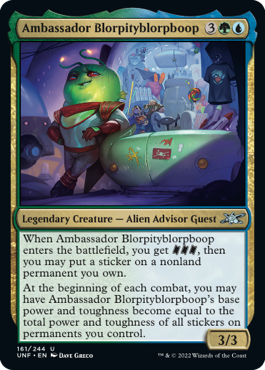
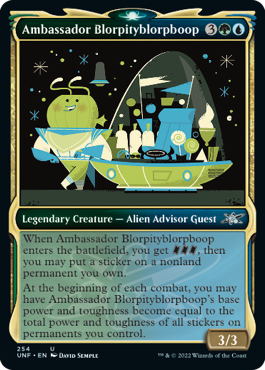
Our first story today is not about the design of the card but rather its naming. Unfinity had a top-notch comedy writing team doing the names and flavor text (the team included Kathleen De Vere, Cameron Lauder, and Graham Stark from LoadingReadyRun, Seanbaby, Austin Bridges, myself, and Ari Zirulnik, the person leading the team).
The way the process works is, we're given cards each week and told whether that card needs a name, flavor text, or both (the reason it might not need a name is because it got one during design, and we wanted to keep it). Each member was expected to turn in at least three suggestions for each slot, although we could turn in more if we had them.
One idea I had from the beginning of the design that I thought would be funny was to have a silly, exceedingly long name for one card. I wasn't sure which card it should be, but I was keeping my eye out. I'm not sure why the Ambassador seemed like the right place. He was a Blorbian, the alien race we'd made specifically for the set. (Captain Rex Nebula accidentally backed over the Blorbians' home planet, so Myra gave them lifetime passes to the park.) He just seemed like the right card. Also, his name ended up getting referenced twice in the rules text, which just made it funnier. My very first stab at the name was Ambassador Blorpityblorpboop. I don't really know where it came from, but it just sprang forth fully formed. I instantly fell in love with it.
I was so excited about it that I shared the name with my design team. They were a bit skeptical. They asked if we should shorten it. I said no. They asked if it should have fewer repeating sounds. There were a lot of b's and l's and p's, and a whole bunch of o's. I said those things were what made it so funny. I knew its fate rested in Ari's hands. I was on the writing team, and I definitely had input, but Ari was in charge. No matter how much I liked it, if Ari didn't like it, it wouldn't be the name. This led to the following exchange:
Me: Okay Ari, I need to get a sense of how close our humor sensibilities are. I'm going to give you a card name, and you tell me if it's funny.
Ari: Okay, shoot.
Me: Ambassador Blorpityblorpboop.
Ari: That's very funny. We can't change that.
Me: I think this is the beginning of a beautiful friendship.
Comet, Stellar Pup

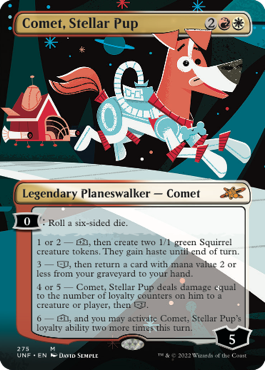
Unsanctioned was a boxed Un- themed product that had fifteen new card designs in it. One of those cards was slotted to be a planeswalker, so I went to the team at the time that oversaw the planeswalkers with a list of ideas I had for Un- planeswalkers.
One of those ideas was for a dog. Not a dog person or a smart talking dog, just an average run-of-the-mill dog. Someone who would dig up a bone on Innistrad and then bury it on Zendikar. The idea of a dog planeswalker was an idea that I got continually for years on my blog and in social media, and I was eager to make one.
An Un- set seemed like the perfect place. Interestingly, when I pitched the idea of a dog, I was told, "Hmm, maybe we'd do that in black border," so I went with a collective of Beebles instead. (That's how we got B.O.B.) Flash forward a couple years, and I'm working on Unfinity. The team that oversaw the planeswalkers (at least for Magic sets) had changed, so I went again with my pitch for a dog planeswalker, and this time I got, "Sure, why not?"
The first question we had to solve was, how do you capture the flavor of a dog planeswalker? After thinking it through, the answer we got was, what if it didn't listen to you? What if the dog would do cool things that you mostly wanted, but it did what it wanted to do, not what you wanted it to do? As this was an Un- set, using a six-sided die seemed like the best way to create the randomness. (This was before Dungeons & Dragons: Adventures in the Forgotten Realms added die rolling.)
We wanted each action to feel like a thing a dog would do but also be an ability that would mostly be positive for you. We started by writing down as many dog actions as we could think of (chase squirrels, dig up bones, etc.). We then turned those into abilities that we thought would be generally useful.
On top of that, we realized that we had to have a means to change the loyalty. There had to be scenarios when Comet would get fed up and leave. We accomplished this by having some effects gain you loyalty and some lose you loyalty. Comet's design name was Laika, the first dog in space. We felt our dog planeswalker should be red-white, so we made sure our mechanics matched the color pie. Here was our first stab at the design:
Laika
1RW
Legendary Planeswalker — Laika
At the start of your main phase, roll a six-sided die and do what you roll:
1 or 2 – Chase Squirrels – Gain loyalty equal to your die roll, then create two 1/1 green Squirrel creature tokens. They gain haste until end of turn.
3 – Dig stuff up – Lose 1 loyalty, then put an artifact from your graveyard into your hand.
4 or 5 – Attack – Lose 2 loyalty, then CARDNAME deals damage equal to its loyalty to any target.
6 – Do tricks – Gain 1 loyalty, then roll again but with two dice.
First up, chase squirrels. This would get you some Squirrels. Because it was 1 or 2, we made use of a mechanic we'd used elsewhere in the set where the die roll affected how much you got from an effect, in this case how much loyalty you gained. For flavor, and to match the token in the set, we made the Squirrels green, but making 1/1 tokens is still a primary white thing.
Second was digging stuff up. An artifact felt like the closest thing to digging up a bone. This was squarely in white.
Third was attacking. Both the previous abilities had been white, so we wanted a red ability. Direct damage felt good. To add some randomness, we decided to tie the damage to loyalty. For some reason, in the first version, we had you lose the loyalty first.
Fourth was an element we wanted to add some extra excitement. There was a chance that Comet would do more than one thing.
We felt the first ability should gain loyalty and the third should lose loyalty, so we gave the second ability a loyalty loss and the fourth ability a loyalty gain to even things out. In this first pass, you lost slightly more loyalty than you gained to make sure that Comet didn't stick around forever.
The basic structure worked, but we had to make a few changes. First, we had to have at least one ability so the dice rolling became a 0: ability (which makes Comet the first planeswalker with just one loyalty ability). Sadly, there was no room for flavor text.
We then made use of the loyalty icons to signify loyalty gain and loss. The "chase squirrels" ability locked into a two-loyalty gain to save space. The "dig up stuff" ability changed from an artifact to an inexpensive spell to maximize its usefulness in most decks. The "attack" ability swapped the loyalty loss until after the damage to strengthen it. The "do tricks" ability basically stayed the same.
The final part of our story was when we reviewed it to figure out whether it would be an acorn-symbol or Eternal-legal card. Since its creation, die rolling had been added to Eternal Magic, so it got the thumbs up to be Eternal legal. Our dog planeswalker is going to see actual play in non-Un- decks. Good dog, Comet.
Devil K. Nevil
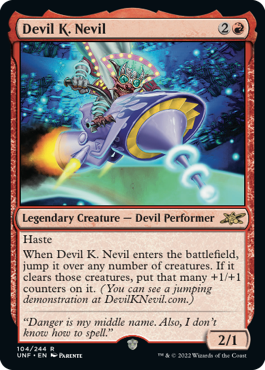
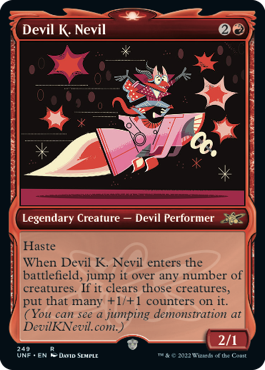
The idea for Devil K. Nevil happened quite early in world building. We wanted the set to have a daredevil as that was one of the tropes we wanted to hit, and as this was Magic, it seemed only appropriate to have a daredevil that was actually a Devil. The trope we wanted to hit with Devil K. Nevil's design was that he jumped over things. Was there a way mechanically to do that?
The first question we asked: what would Devil K. Nevil jump over? We wanted it to be something on the battlefield, which meant it had to be either land or creatures. Jumping over land seemed flavorfully less interesting than jumping over creatures, so we decided that he would jump over creatures. Well, what exactly did jumping over creatures mean? As this is an Un- set, our first thought was to have him literally jump over creatures. But how?
We lined up a bunch of creatures in a row, side by side, and then tried different ways to have him jump over. We tossed him, we scooted him, we flung him, we tried lots of different options. What felt best was when he physically went up in the air before the line of creatures and then landed after the line of creatures. That action best captured the flavor of what we were after.
We ended up using a technique from a game I'd played as a kid at camp. First, you put a folded piece of paper half on, half off a table and then flick it upward to make it jump into the air. A Magic card has the right heft to make this ability work and allowed us to line up Devil K. Nevil facing the line of creatures he was about to jump over. We liked the idea that Devil K. Nevil, with consultation of his controller, could decide how many creatures he wanted to jump over (within the limitation of however many creatures were on the battlefield), so the card would have a bit of a "push your luck" element. We could then reward Devil K. Nevil with a scaling effect that could reflect how many creatures he jumped over. +1/+1 counters combined with the creature having haste ended up being the perfect answer.
We figured all of this out easily and were happy with how it played. Just one small problem. How exactly do you explain how the card works in its rules text? Here was our best shot at it:
Haste
When CARDNAME enters the battlefield, arrange any number of creatures on the battlefield horizontally side by side starting one vertical card's length away from the edge of the table. Position CARDNAME vertically one third off the table in line with the creatures. With one upward motion, hit CARDNAME into the air. If it lands past the end of the farthest creature, put a +1/+1 counter on it for each creature it jumped over.
We showed this text to Matt Tabak, the set's editor, and he responded, "This text is going to have to be a lot longer." In fact, he wasn't sure it would even fit on the card. There was a lot of things that needed to be explained, and Magic rules text has a preciseness to it that tends to add words. On top of all that, we wanted the card to have flavor text, as it's one of our main characters.
The design team was frustrated. When we showed people what it did, they got it immediately. It's a very top-down mechanic, and when you see it all presented, you understand what's supposed to happen. It was just hard to "show" people in rules text.
That's when it hit us. This was an acorn card (due to the physical dexterity), so we had options that normal Eternal cards didn't. For example, we'd been looking for ways to integrate the set with technology (with cards like Mobile Clone and Photo Op). What if the card could show you how it worked. Unstable had Urza, Academy Headmaster, where you had to go to the internet to see what he did. What if Devil K. Nevil got a video rather than a block of rules text? Our first pass on reminder text was "(It's complicated. Go check it out at <website address>.)"
Here's that link and the video (made by our friends at LoadingReadyRun) below:
D00-DL, Caricaturist
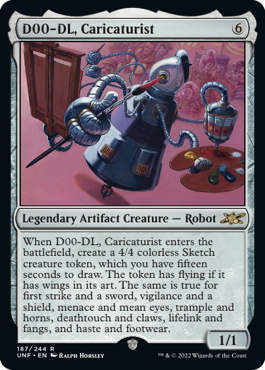
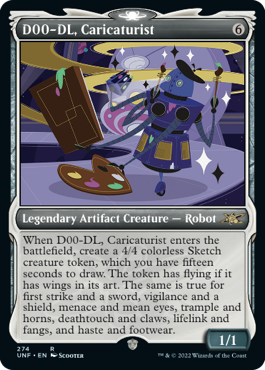
In The Pit (where most of Magic R&D sits), we have a lot of blank cards lying around. In playtesting, we often will have tokens that don't exist yet in a printed form. Sometimes, a playtester will pick up a Sharpie and make their own token. That was basically the inspiration for this card. What if we had a card that created a token which made the player draw it? A good seed for an Un- card design, especially an acorn card, is to come up with a fun activity and then figure out what about it would lead to enjoyable gameplay. Okay, what if what the player drew mattered? What if the act of drawing the card impacted its abilities? That seemed fun.
This meant we had to come up with physical things you could draw that would imply different evergreen creature keywords. (We'd chosen to make it a colorless artifact to allow us access to whatever keyword we wanted.) Wings and flying were the low-hanging fruit. Were there any other body parts that would imply some ability? We could use horns for trample, fangs for deathtouch, and claws for menace.
We then asked if there were items the creature could have that would imply other abilities. The low-hanging fruit for this was a sword and first strike. We also used a shield for vigilance, a bow for reach, armor for hexproof, and footwear for haste. The token was a 4/4 from the earliest incarnation of the card. We decided, for flavor, to make the creature a caricaturist, as that was on our list of carnival tropes. For power reasons, we made it a 1/1. We made the card a Robot because it was an artifact. It's one of three non-Clown Robots in the set, and the only legendary Robot. Also, from the very beginning, we let the player have fifteen seconds to draw the token. It was enough time to draw something, but not enough to draw everything. (This was another reason we wanted a lot of abilities, so the player would have to make choices.)
Playtesting had shown this was a super-fun card to play, but we ran into a few problems. First up, not everything we'd picked was easy to draw quickly. Our philosophy with the card was that the player did the best they could and basically could just explain what they drew, but armor just didn't have an easy iconic thing to draw. You couldn't just show your sketched token to another player and have them ever guess that you drew armor (well, unless you were a talented artist). In addition, hexproof proved to be a pretty unfun ability, so it seemed right to cut it entirely.
We then realized that we'd forgotten lifelink, which seemed like the kind of ability players might want. So, we racked our brains thinking what lifelink would want to be? Nothing came to mind until we thought about it in terms of Vampires. What if fangs represented lifelink? But fangs were being used for deathtouch. Deathtouch could be claws, but then we didn't have something for menace. We decided it would be easier to come up with something new for menace than deathtouch, so we gave claws to deathtouch. What could menace be?
Meanwhile, we'd noticed that no one ever drew a face on the creature because they were so busy drawing things that mechanically mattered. Was there a way to make eyes matter? Could eyes be menace? Why would eyes be menacing? What if they were mean eyes? That led to us having a big laugh and saying, "Let's do it." It only took one playtest to realize that mean eyes were an awesome addition.
The final change to the rules text came when we'd asked ourselves if all the abilities were getting used. It turned out that eight of the nine had been used. The one that hadn't was reach. Most of the time, you would give the creature flying, so reach was just repetitive. We ended up cutting reach, which is good, because, as we laid out the card, I don't think a ninth ability would have fit.
The last tweak to the card was making it legendary. We had thirty slots for legendary creatures and had a bunch of slots left after filling in everything we needed for Draft and story reasons. We wanted a colorless acorn commander, and the card had proven to be a lot of fun in play, so we chose to make it a legendary creature.
I'm happy with how D00-DL ended up. I hope you all get a chance to sketch your own creature tokens.
Grand Marshal Macie
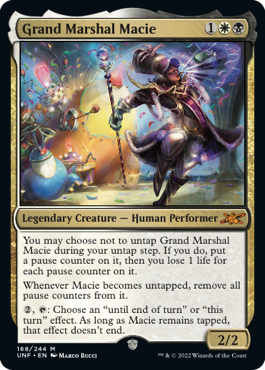
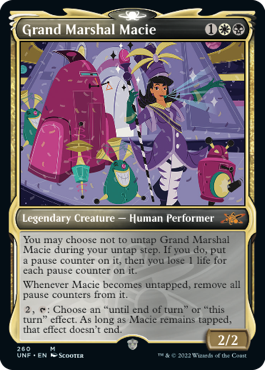
Many years ago, I made a white enchantment that kept temporary effects from wearing off. If you Giant Growth-ed a creature, for example, it would get that +3/+3 bonus for the rest of the game rather than the end of the turn. I put it into a set. It got removed by the Rules Manager. Following a time-tested strategy, I waited for a new Rules Manager and then put it into a different set. It again got removed by the Rules Manager. After this happened three times, I decided to put it into Unhinged. The Un- sets were a perfect home for cards that players could understand but the rules had issue with, not with its practical use case, but mostly in weird corner cases.
Staying Power came out, and players, at least those who'd talked to me about it, either adored it and/or complained to me that it shouldn't be in an Un- set. When looking for Unfinity designs, I was intrigued by the idea of a creature that could activate to do what Staying Power did rather than be a global effect. Here was the first stab at the design:
Modifying Wizard (version #1)
WU
Creature — Human Wizard Employee
2/2
1: Target "Until end of turn" or "this turn" effect doesn't end as long as CARDNAME is on the battlefield.
You'll note that this creature started as a white-blue creature. I wanted the ability on a multicolor color creature, and white-blue felt like the best fit. Also, for some reason, the card didn't start as a legendary creature, but that's probably because I wasn't thinking about whether this wanted to be a potential commander yet.
Modifying Wizard (version #2)
WU
Creature — Human Wizard Employee
2/2
W: Target "Until end of turn" or "this turn" effect doesn't end as long as CARDNAME is on the battlefield.
U, T: Add or subtract 1 to target number of number word on any permanent or spell. This effect is permanent.
It turns out there was another old Un- card with an effect that I wanted to turn into an activated ability on a creature—More or Less from Unstable. (It allowed you to tweak numbers up or down by one.)
The two abilities felt related to me, as you're rewriting how spells and effects function, so I put both abilities on this card. Because the Staying Power ability felt more white, I made that the white activation, and because the More or Less ability felt more blue, I made that the blue activation. I think the white ability didn't tap solely because I just carried over the ability from version #1. It turns out both abilities were pretty powerful, which led to version #3.
Modifying Wizard (version #3)
WU
Legendary Creature — Human Wizard Employee
2/2
You may choose to not untap CARDNAME during your untap step.
{oW}, {oT}: Target "Until end of turn" or "this turn" effect doesn't end as long as CARDNAME remains tapped.
{o2oU}, {oT}: Add or subtract 1 to number or number word on target permanent or spell. This effect lasts as long as CARDNAME remains tapped.
Now the white Staying Power ability tapped and the blue More or Less ability required more mana. All should be good, right? No. It turns out that both abilities were bonkers good. It was also at this time that the design team concluded that the two abilities were cool enough that they could each be their own card. Also, it was at this point that we started to question which effects were in which color.
We had three rare and/or mythic rare legendary creature slots—white-blue, blue-black, and white-black—to fill three different effects. One was going to be the Staying Power effect, one the More or Less effect, and one an effect that allowed token creatures to survive in other zones. The Staying Power ability wanted to be in white, and the More or Less ability wanted to be in blue. The token-survival ability had been in white-black, but we realized it could work with just white or just black, it didn't need both, so it could go in any of the three slots.
What got Macie into white-black was the next tweak. We needed some cost for using the ability and the simplest extra cost was life loss, which is more black than any other color.
Macie, Parade Leader (version #4)
1WB
Legendary Creature — Human Performer
2/2
{o1}, Pay 1 life: Choose an "Until end of turn" or "this turn" effect. That effect doesn't end until the end of the following turn.
It was at this point that we started getting some play design input, and the ability was significantly too strong, so we tried a version where you had to keep the creature tapped to keep the effect duration going. That was still too strong, so we changed the life loss from 1 life a turn to growing over the turns. The longer you kept the effect going, the more painful it got for you. This fix proved to be enough.
The More or Less effect would go to blue-black and become Truss, Chief Engineer, and the token-survival effect would move to white-blue and become Claire D'Loon, Joy Sculptor.
Snap!
That's all the time I have for today. I hope you enjoyed the stories. As always, if you have any feedback on the article, the cards I talked about, or on Unfinity itself, you can email me or contact me through my social media accounts (Twitter, Tumblr, Instagram, and TikTok) with feedback.
Join me next week for more Unfinity card-by-card design stories.
Until then, may playing Unfinity create many stories for you to tell.
#971: UNF with Chris Mooney
#971: UNF with Chris Mooney
35:52
Chris Mooney was my strong second on Unfinity from the first day of exploratory design to the last day of set design. We sit down to talk about the stories of several card designs.
#972: Unfinity Design, Part 1
#972: Unfinity Design, Part 1
33:39
This podcast is part one of a multi-part series on the design of Unfinity.
- Episode 970 Joel Mick
- Episode 969 Feature Matches
- Episode 968 DMU Set Design with Erik Lauer & Ian Duke

